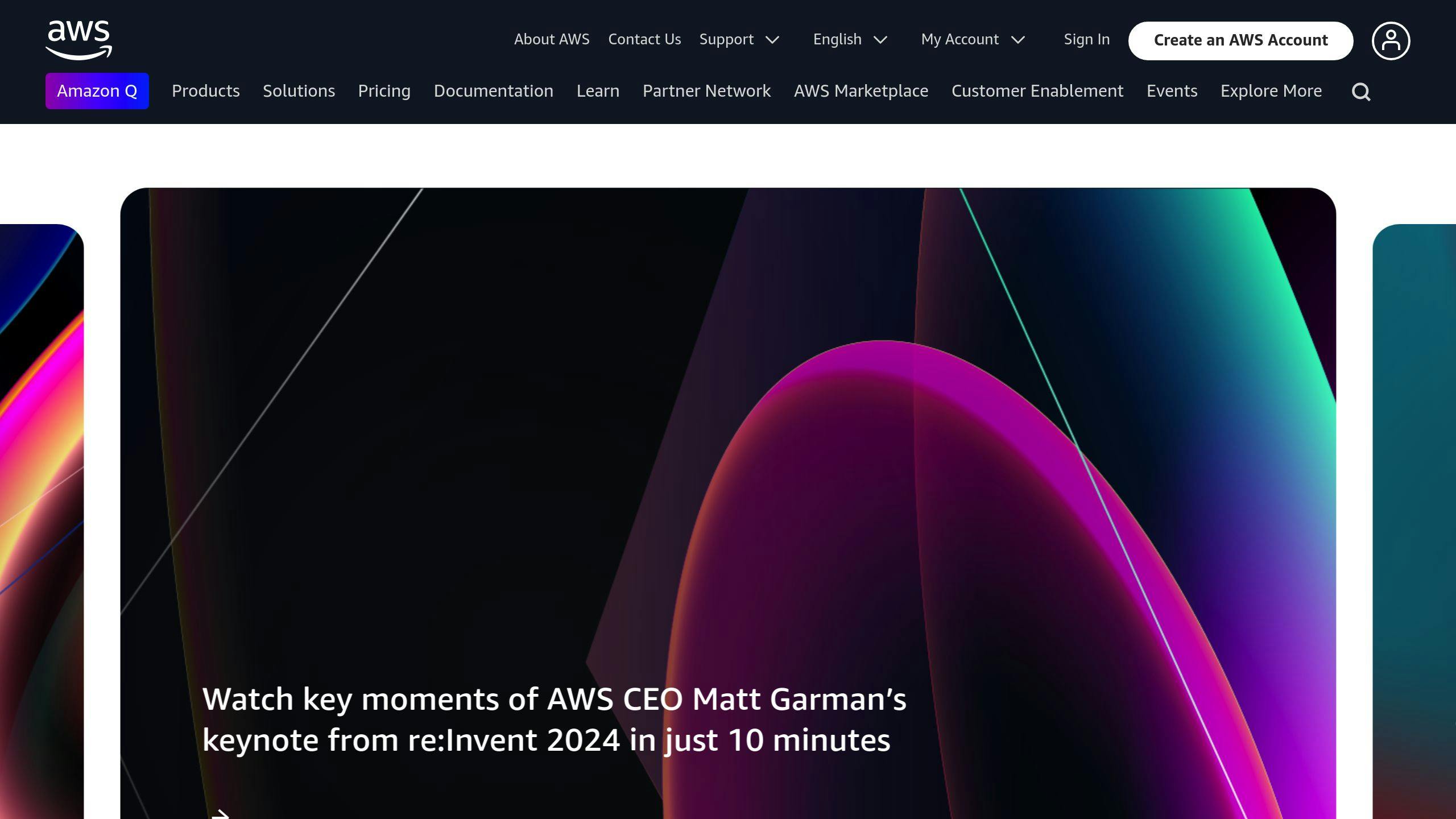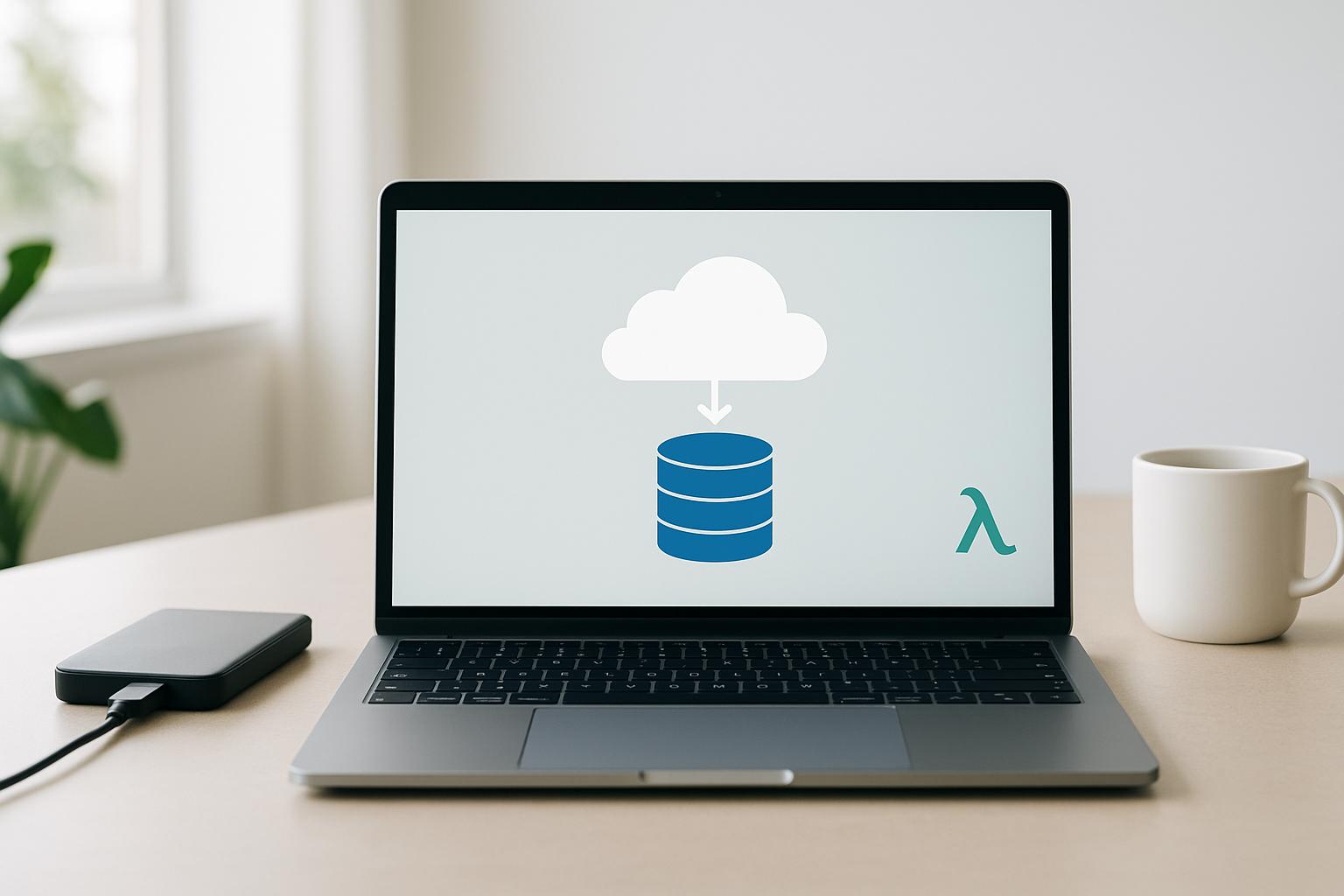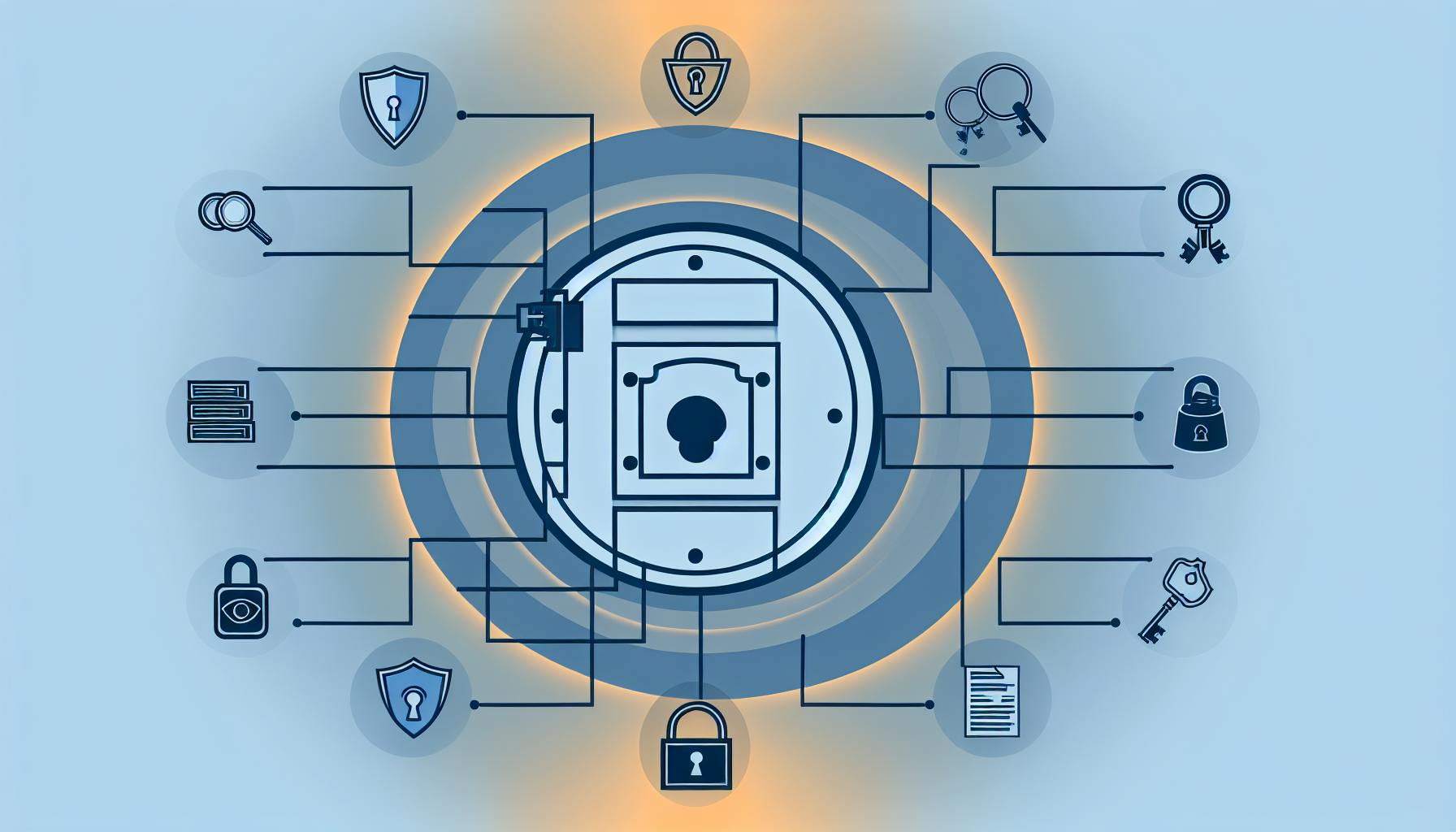Looking to build efficient, scalable, and secure applications on AWS? Start with a multi-tier architecture. This approach divides your application into three layers - Presentation, Logic, and Data - each with specific AWS services designed for optimal performance.
Key Takeaways:
- Presentation Layer: Manages user interactions using tools like Elastic Load Balancer, CloudFront, and AWS Amplify.
- Logic Layer: Processes workflows with AWS Lambda, API Gateway, or EC2 for flexibility and scalability.
- Data Layer: Handles storage with RDS for structured data, DynamoDB for NoSQL, and S3 for object storage.
Benefits:
- Independent scaling of layers for cost-effective resource use.
- Enhanced security with IAM roles, VPCs, and encryption.
- High availability using multi-AZ deployments and auto-scaling.
Quick Overview:
| Tier | Services | Purpose |
|---|---|---|
| Presentation | CloudFront, Amplify, ELB | User interaction, content delivery |
| Logic | Lambda, EC2, ECS | Business workflows, app processing |
| Data | RDS, DynamoDB, S3 | Data storage, backups, and fault tolerance |
AWS multi-tier architecture ensures reliability, security, and scalability for modern applications. Keep reading for detailed implementation steps, cost management tips, and advanced patterns like serverless and multi-region setups.
AWS Multi-Tier Building Blocks

In a multi-tier AWS architecture, each layer has a distinct role and requires careful selection of AWS services to meet its purpose. Below, we break down the key components and services for each tier.
Front-End Services
The front-end, or presentation tier, manages user interactions. AWS services like Amazon CloudFront and AWS Amplify are commonly used to ensure fast, reliable, and scalable delivery of content and applications.
| Component | AWS Service | Key Role |
|---|---|---|
| Content Delivery | CloudFront | Distributes content globally, caching |
| Web Application | AWS Amplify | Builds and hosts front-end applications |
| SSL/TLS Security | Certificate Manager | Secures communication |
| Protection | AWS WAF | Shields apps with a web application firewall |
This tier ensures smooth interaction for users. Once this is in place, the focus shifts to managing the core business logic.
Business Logic Layer
The business logic layer executes application workflows and processes business rules. AWS offers flexible compute services to match workload needs.
| Service Type | Best Use Case | Scaling Approach |
|---|---|---|
| EC2 | Long-running processes | Auto-scaling groups |
| Lambda | Event-driven tasks | Scales automatically |
| ECS | Containerized apps | Scales containerized workloads |
This layer handles all application logic before passing data to the storage systems.
Data Storage Layer
The data storage layer ensures secure and efficient handling of both structured and unstructured data. AWS provides multiple services tailored for different types of storage needs.
| Storage Service | Data Type | Key Features |
|---|---|---|
| RDS | Structured | Automated backups, Multi-AZ support |
| DynamoDB | NoSQL | Global tables, auto-scaling |
| S3 | Objects | Cross-region replication, scalable storage |
To maintain performance, use replication and monitoring tools like CloudWatch for tracking storage, I/O, and latency metrics across availability zones. This ensures data reliability and efficiency.
Implementation Guidelines
Building multi-tier systems on AWS requires a focus on uptime, security, and performance. Here's how to address these aspects effectively.
Uptime and Redundancy
To ensure high availability, deploy components across multiple Availability Zones (AZs) with redundancy mechanisms like Auto Scaling and Multi-AZ RDS. Here's a breakdown:
| Component | Implementation Strategy | Key Benefit |
|---|---|---|
| Web Tier | 2 public subnets with Elastic Load Balancers and Auto Scaling Groups | Keeps services running during zone failures |
| Application Tier | 2 private subnets with Auto Scaling Groups | Ensures secure and scalable processing |
| Database Tier | Multi-AZ RDS deployment | Provides automated failover capabilities |
"Failures are inevitable; design for recovery." - Werner Vogels, CTO of Amazon [1]
Use automated health checks and failover mechanisms to maintain service continuity. For example, one public sector organization achieved over 6,000 deployments per week by leveraging robust automation [2].
With redundancy in place, the next step is to secure the architecture.
Security Implementation
Protect your system by addressing security at multiple layers:
| Security Layer | Implementation Method | Purpose |
|---|---|---|
| Access Control | IAM roles, VPC security groups, NACLs | Restricts access and isolates system tiers |
| Data Protection | AWS KMS encryption | Safeguards data at rest and in transit |
For added security, configure database tier security groups to accept traffic only from the application tier's security group. Stay updated on AWS security advisories and adjust configurations to counter new threats.
Once security is in place, shift your focus to improving performance and responsiveness.
Speed and Efficiency
- Caching: Use ElastiCache for frequently accessed data to reduce load times.
- Auto-Scaling: Set auto-scaling policies based on CPU usage and latency, including warm-up periods to avoid performance dips.
- Latency Reduction: Leverage CloudFront, regional caching, and database read replicas to minimize delays.
Track performance using CloudWatch metrics to make informed scaling decisions. Regular audits and performance testing will help ensure the system remains both reliable and efficient over time.
Modern Multi-Tier Patterns
Building on core principles, modern multi-tier patterns utilize advanced AWS services to improve scalability and adaptability.
Serverless Architecture
Serverless architecture eliminates server management by using AWS Lambda and API Gateway, offering automatic scaling and cost-efficient operations. This approach refines traditional multi-tier designs while maintaining performance and reliability.
| Component | Service | Benefits |
|---|---|---|
| API Layer | API Gateway | Handles request throttling, authentication |
| Business Logic | AWS Lambda | Scales automatically, pay-as-you-go pricing |
| Data Layer | DynamoDB | Serverless, low-latency performance |
To maximize efficiency, configure Lambda functions with suitable memory and timeout settings. Pairing DynamoDB's on-demand capacity mode with Lambda ensures a fully scalable and elastic system.
Microservices Design
AWS supports microservices architecture through tools like ECS, EKS, and Fargate, enabling independent, loosely coupled service deployments.
| Service | Use Case | Benefits |
|---|---|---|
| ECS | Traditional container workloads | Simplifies orchestration |
| EKS | Kubernetes-based setups | Offers advanced orchestration |
| Fargate | Serverless container hosting | Reduces operational overhead |
AWS Cloud Map simplifies dynamic service discovery in microservices setups. Combine application load balancers and circuit breakers to manage inter-service communication and improve system resilience.
Multi-Region Setup
Multi-region architectures ensure global availability and meet compliance needs by extending redundancy strategies.
| Component | Implementation | Purpose |
|---|---|---|
| DNS Management | Route 53 | Routes global traffic |
| Content Delivery | CloudFront | Provides edge caching |
| Data Replication | DynamoDB Global Tables | Ensures cross-region consistency |
"Successful multi-region deployment requires balancing consistency and availability based on application needs", according to AWS's Well-Architected Framework documentation [2].
To optimize multi-region performance:
- Use Route 53 latency-based routing and CloudFront for managing global traffic and delivering static content efficiently.
- Configure cross-region replication for data stores to maintain consistency.
Keep regional compliance requirements in mind when designing multi-region systems. Leverage AWS Organizations to manage multiple accounts and enforce consistent security policies across regions.
These patterns extend the capabilities of traditional multi-tier architectures, addressing the demands of modern applications with advanced AWS tools and services.
sbb-itb-6210c22
System Management and Costs
Managing systems effectively and keeping costs under control are key to ensuring scalability, security, and performance in multi-tier architectures on AWS.
AWS CloudWatch Setup
AWS CloudWatch helps centralize monitoring by combining logs, setting up alerts for key metrics, and creating dashboards to provide real-time insights. You can define custom metrics specific to your application, like user request rates or error frequencies, to gain a deeper understanding of system performance.
| Monitoring Component | Purpose | Implementation |
|---|---|---|
| Performance Metrics | Monitor system health | CPU, memory, latency metrics |
| Log Groups | Track errors | Application logs, access logs |
CloudWatch enables you to keep an eye on system health using metrics like CPU usage, memory, and latency. Build custom dashboards and set alerts to visualize performance in real time and take action when needed.
Resource Scaling
Once monitoring is in place, the next step is managing resources dynamically to meet changing demands efficiently.
Auto-scaling ensures resources are used effectively. Use target tracking for steady workloads, step scaling for variable demand, and scheduled scaling for predictable usage patterns. Set cooldown periods to avoid unnecessary scaling adjustments.
| Scaling Type | Use Case | Configuration |
|---|---|---|
| Target Tracking | Steady workloads | CPU utilization targets |
| Step Scaling | Fluctuating workloads | Multiple threshold steps |
| Scheduled Scaling | Predictable demand | Time-based scaling |
"Using auto-scaling groups to scale EC2 instances in the application layer can help maintain optimal performance during peak usage periods while reducing costs during low-demand periods", according to AWS Well-Architected Framework documentation [1].
For detailed setup tips, revisit the scaling strategies discussed in the 'Speed and Efficiency' section. While scaling improves performance, keeping costs in check is equally important.
Cost Management
AWS provides tools to help you control expenses while maintaining system efficiency. Use Cost Explorer to analyze usage, AWS Budgets to set spending alerts, and Trusted Advisor for recommendations to optimize resources. Reserved Instances are ideal for predictable workloads, and tagging resources helps track expenses more effectively.
| Tool | Function | Benefits |
|---|---|---|
| Cost Explorer | Analyze usage | Detailed cost insights |
| AWS Budgets | Monitor spending | Automated alerts |
| Trusted Advisor | Optimize resources | Improved efficiency |
Maximize savings by combining Reserved Instances with tagging strategies. Cost Explorer is particularly useful for identifying areas where you can cut costs through detailed analysis and actionable insights.
Summary
Key Points
Building a multi-tier architecture on AWS requires thoughtful planning to ensure performance, security, and cost management. The three core layers - presentation, logic, and data - each serve unique roles but must work seamlessly together. Each layer demands specific strategies for security, scaling, and monitoring.
The key elements for success include:
- Isolating tiers using VPCs and security groups for added security
- Using auto-scaling and load balancing to maintain reliability
- Protecting data with encryption and controlled access
- Employing thorough monitoring tools and cost management techniques
These principles form the backbone of a strong multi-tier AWS setup. Let’s break down the steps to bring this architecture to life.
Implementation Steps
Setting up a multi-tier AWS architecture requires a methodical approach to balance scalability, security, and expenses:
1. Infrastructure Setup
Design a VPC with public and private subnets spread across multiple Availability Zones. Add Internet Gateways for public access and NAT Gateways for secure outbound communication from private subnets.
2. High Availability Configuration
Distribute resources across multiple Availability Zones. Use Auto Scaling Groups and Application Load Balancers to maintain steady performance and handle traffic spikes.
3. Security Implementation
Apply security groups tailored to each tier. Use encryption to safeguard sensitive data and AWS Secrets Manager to securely store and manage credentials.
4. Monitoring and Optimization
Utilize CloudWatch to track performance metrics and Auto Scaling to adjust resources automatically based on demand, ensuring smooth operation and cost control.
FAQs
What are the 3 tiers of the three-tier model in cloud computing?
The three-tier architecture in cloud computing is made up of three layers, each responsible for a specific role in building a complete application infrastructure:
| Tier | Primary Function | Common AWS Services |
|---|---|---|
| Presentation Tier | Manages user interface and interactions | Amazon CloudFront, Elastic Load Balancer |
| Logic Tier | Handles business rules and data processing | Amazon EC2, AWS Lambda, Auto Scaling Groups |
| Data Tier | Focuses on data storage and retrieval | Amazon RDS, DynamoDB, S3 |
- Presentation Tier: This layer deals with user interfaces, delivering content to users and capturing their input. It stays separate from the business logic to ensure flexibility.
- Logic Tier: This is where business rules are processed. It connects the user-facing presentation tier with the data-handling layer, ensuring smooth communication between the two.
- Data Tier: This layer is all about securely storing and managing data. It ensures data integrity and reliable access.


